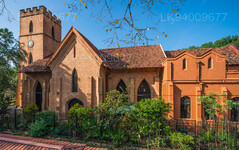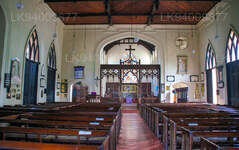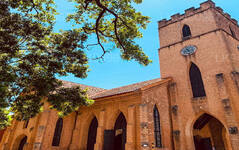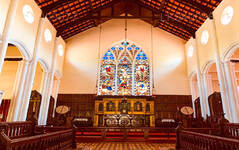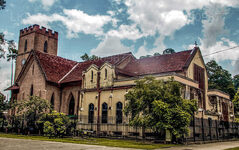
캔디 시티
스리랑카 중부의 그림 같은 도시 캔디는 풍부한 문화 유산, 활기찬 축제, 그리고 아름다운 자연 경관으로 유명합니다. 울창한 언덕에 자리 잡은 캔디는 유네스코 세계문화유산으로 지정된 불치사(Temple of the Tooth Relic)가 있는 곳으로, 역사와 아름다운 자연이 어우러진 매혹적인 도시입니다.
St Pauls Church
St Paul’s Church is an Anglican Church located in an area called Milagiriya in Colombo 04, Sri Lanka. It has its origins in the Portuguese era of the 16th century. Today it is one of the oldest and most historic churches within Colombo and is also well known due to the attached girls’ school. Here’s the story of how it came to be:
The Early Portuguese Church
Over four centuries ago, when the Portuguese invaded Sri Lanka – they caused mass destruction to the local religions and built Roman Catholic Churches to spread their discipline of Christianity. It is unknown why they chose to build a church at that specific location, but perhaps there may have been some sort of locally popular shrine there that they destroyed and built over – as was their habit.
The newly built church, at the time, was known as ‘Nossa Senhora dos Milagres’ or ‘Our Lady of Miracles’. The locals, due to their lack of knowledge and understanding about the Portuguese language, took to calling the church ‘Milagres’, which is actuality meant ‘Miracles’. With time the name evolved, and the entire area surrounding the church came to be known as ‘Milagiriya’.
The British Takeover
However, the ‘Church of Miracles’ did not last. Approximately a century later, Ceylon was invaded by the Dutch who suppressed the Portuguese and wrested control of the valuable trade route island from them. To consolidate their rule, the Dutch thoroughly destroyed all Portuguese monuments and churches that they could find. Nossa Senhora dos Milagres was one of these churches that fell under their hands. The consecrated land remained bare for over a century, until the British decided to invade and took control of Sri Lanka from the Dutch.
The Building of St Paul’s
In the 1840s, a large number of Anglican churches started to get constructed. The premise behind them was mainly to give places of worship for British countrymen, but also to persuade the native population to change their religion and follow the Anglican discipline.
St Paul’s Anglican Church, which was built over the ruins of the old Portuguese church in Milagiriya, was one such church built by the British. The construction of the church began in 1948 under the initiation of the British cleric, Reverend Joseph Thurston, who dedicated it to St Paul. It was completed in 1953 and consecrated by the Bishop of Colombo at the time. An attached industrial school was also built at the same time to give a place of learning for Anglican youth. However, the main attraction was the font within the church grounds, hailing from the time of the previous Portuguese church. Its water was said to have miraculous healing properties, and sick people from all over the country visited the church to experience this healing.
Between the 1890s to the early 1900s, the church flourished and many locals joined the congregation as well. This was also partly due to the efforts of the first two vicars, Rev. John Ford and Rev. Harry Marsh ,who worked within the neighborhood to help the natives at their times of need.
A Change in Leadership
In the early 1900s, with the arrival of the First World War, the British began losing interest in Sri Lanka. Many Englishmen and other Europeans left the island, returning to their home countries or moving to the newly settled land of Australia. The leadership of St Paul’s fell into the hands of the elite and influential members of the congregation, and the very first native Sri Lankan Vicar for the church was elected in 1920. Rev. Paul Lucien Jansz took up official duties as the third vicar of St. Paul’s, and continued till 1953.
In the meantime, the Second World War occurred in the 1940s and the British lost much of their troops. It spelled the death knell to Britian’s supremacy over the countries in the East and Far East. They gave independence to most of those countries that they had established a rule over, and returned back to England or went to Australia. By the 1950s and 1960, when Rev Jansz ended his term as the vicar of St Paul’s, there were little to no British clergy left to take over the office and the vicarage continued to be passed over to Sri Lankans – fulling transferring the leadership to native hands.
The Church as it is Today
Today St. Paul’s Church in Milagiriya comes under the Church of Ceylon, the main Anglican Church in Sri Lanka, and is part of the diocese of the Archbishop of Canterbury. The vicars throughout the years continued to grow and develop the church, making it extremely popular amongst the Colombo population. Today the congregation consists of a large mixed crowd of individuals: Sinhalese, Tamils, Burghers, and Europeans who stay in Sri Lanka for longer periods.
The church itself resembles a Greek Basilica. Five services occur on Sunday in the church’s chapel in the left wing, named ‘Chapel of our Lady’, where the original 19th century altar still remains. The miraculous font is still popular and visited by many church goers. The attached school that once was a place of industrial learning, was converted into a government managed learning institution for girls and became known as St. Paul’s Girls School, Milagiriya. The most recent renovations to the church added a service center for children and adults.
St Paul’s often community activities for disadvantaged children. They run a home for disabled children in the region of Mayura Place in Havelock Town. There is also a project done by the church that benefits children from the slums near the stations of Colombo 4 and Colombo 6.
The church also maintains links to congregation members who migrate abroad and churches from other countries. This provides them a global perspective that which they then implement among the local community.
Today any visitor is warmly welcomed by the vicar and/or clergy, and can take part in the services and community activities of the church if they wish to. The vicar is also quite happy to give further insights to the history of the church and point out places of interest within the church grounds. So it’s definitely a peaceful and interesting place to go to if you’re in Colombo.
캔디 지구 소개
캔디 지구는 스리랑카 중부 지방에 위치하고 있습니다.스리랑카의 7개 세계문화유산 중 하나인 캔디는 16세기에 옛날 캔디 왕조의 왕들이 살았던 곳이자 나라의 모든 음악, 예술, 공예, 문화의 원천이었습니다.콜롬보에서 약 129km 떨어진 캔디는 구릉 지대에 자리 잡고 있으며 모든 시선은 캔디 호수가 매력적인 특징을 이루는 도시 중심부로 쏠립니다.캔디는 스리랑카에서 큰 종교적 의미를 지니고 있는데, 이 매력적인 도시에 달라다 말리가와 또는 "치아 사원"이 있고, 그 안에 부처님의 신성한 치아 유물이 잘 보관되어 있기 때문입니다.페라데니야 왕립 식물원은 페라데니야 시내 중심에서 서쪽으로 약 5km 떨어진 곳에 위치하고 있으며, 매년 120만 명이 방문합니다.섬에서 가장 큰 식물원입니다. 우다와타 켈레(우다와타 숲)는 도시 중심부, 불치사 바로 북쪽에 위치한 보호 구역입니다. 캔디는 싱할라족이 다수를 차지하는 도시이지만, 무어족과 타밀족 등 다른 민족 집단이 거주하는 지역 사회도 상당수 있습니다. 캔디는 스리랑카 경제의 중심지인 콜롬보에 이어 두 번째로 큰 도시입니다. 많은 주요 기업들이 캔디에 대규모 지사를 두고 있으며, 섬유, 가구, 정보 기술, 보석 등 다양한 산업이 이곳에 자리 잡고 있습니다. 또한, 수많은 농업 연구 센터가 캔디에 위치해 있으며, 전국의 음악, 예술, 공예, 문화의 발원지이기도 합니다. 콜롬보에서 약 129km 떨어진 캔디는 구릉 지대에 자리 잡고 있으며, 모든 사람의 시선은 캔디 호수가 있는 매력적인 도시 중심부로 쏠립니다. 캔디는 스리랑카에서 매우 중요한 종교적 의미를 지니고 있는데, 이 매력적인 도시에 달라다 말리가와(불치사)가 자리 잡고 있으며, 이곳에는 부처님의 성스러운 불치가 잘 보관되어 있기 때문입니다.
중부 지방 소개
스리랑카 중부 지방은 주로 산악 지형으로 이루어져 있습니다. 이 지방의 면적은 5,674km²이고 인구는 2,421,148명입니다. 주요 도시로는 캔디, 감폴라(24,730명), 누와라 엘리야, 반다라웰라가 있습니다. 인구는 싱할라족, 타밀족, 무어족이 섞여 있습니다. 언덕 주도인 캔디와 누와라 엘리야는 모두 중부 지방과 스리 파다에 있습니다. 이 지방은 1860년대에 파괴적인 질병으로 인해 이 지방의 모든 커피 농장이 파괴된 후 영국인이 심은 유명한 실론 차를 많이 생산합니다. 중부 지방은 캔디, 감폴라, 해튼, 누와라 엘리야와 같은 언덕 역 마을이 있어 많은 관광객을 유치합니다. 템플 투스 또는 달라다 말리가와는 중부 지방의 주요 성지입니다. 기후는 시원하며, 해발 1,500m 정도의 많은 지역에서는 종종 밤에 쌀쌀합니다. 서쪽 경사면은 매우 습하며, 일부 지역에서는 연간 강수량이 거의 7,000mm에 달합니다. 동쪽 경사면은 북동 몬순의 영향으로 비가 거의 내리지 않아 중건기 지대에 속합니다. 캔디의 기온은 24°C에서 해발 1,889m에 위치한 누와라 엘리야의 기온은 16°C에 불과합니다. 스리랑카에서 가장 높은 산은 중부 지방에 있습니다. 지형은 대부분 산악 지대이며, 깊은 계곡이 지형을 가로지르고 있습니다. 두 개의 주요 산악 지역은 캔디 동쪽에 있는 중앙 산괴와 너클스 산맥입니다.

